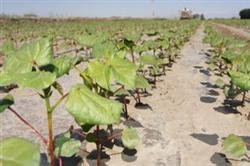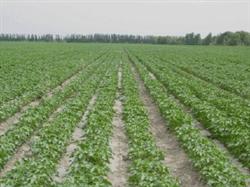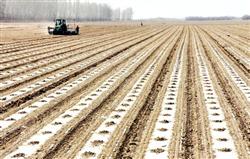How to improve the emergence rate and seedling preservation rate of cotton in spring

The main reasons for the low emergence rate and low seedling preservation rate of cotton are the poor quality of soil preparation: uneven land, uneven soil moisture and thick dry soil layer in some places, which can not produce the whole seedling after sowing. Long-term plastic film cotton planting: resulting in too much residual film on the surface of the soil, resulting in part of the seeds sowing directly on the plastic film in the soil can not emerge, or some seeds are just rooted in the residual film after emergence, resulting in dead seedlings. Climate reasons: cotton seed germination requires a certain temperature and humidity, if there is a strong wind cooling after sowing or a long period of rain and humidity, it is bound to affect seedling emergence. If the method of plastic film mulching and then sowing is adopted, the rain within one week after sowing will cause the hardening of the topsoil of the sowing hole and affect the emergence of seedlings. Artificial release of seedlings is not timely: in the planting mode of sowing first and then mulching with plastic film, untimely release of seedlings after emergence will also result in failure of normal emergence. The weather in spring is changeable: after emergence, there are irresistible natural disasters such as strong wind, drought, low temperature, overcast and rain, which are easy to cause dead seedlings. Harm of diseases and insect pests: cotton seedling diseases and insect pests are also easy to cause dead seedlings. Countermeasures to improve the emergence rate and seedling preservation rate of cotton to improve the quality of soil preparation: spring sowing cotton to ensure a tillage depth of not less than 25 cm, uniform ploughing, flat surface after ploughing. The cotton planting with plastic film for a long time should take advantage of soil preparation to pick up the residual film, give the seed a good environment and improve the seedling emergence rate. Selection of high-quality seeds: in the selection of varieties, seed selection should be not only excellent, but also high-quality varieties. Only high-quality seeds can ensure the germination rate and improve the emergence rate. Improve sowing quality: generally, spring sowing in open field is the most suitable period in mid-late April, plastic film cotton can be advanced to early April, sowing in suitable soil moisture is required, and the sowing depth is about 3 cm. Pay close attention to weather changes: make preparations for disaster prevention and reduction, and strive to minimize the losses caused by natural disasters. Prevention and control of diseases and insect pests: cotton seedling diseases are mainly divided into root disease and leaf disease. The main root diseases at seedling stage are blight, anthracnose, red rot and so on. The main leaf diseases at seedling stage were black spot, stem blight and angular spot. The main pests in cotton seedling stage are cotton aphid, thrips, ground tiger, red spider, stink bug and so on. The disease can be sprayed with 50% carbendazim wettable powder 500 times 800 times, or 70% topiramate 800 times 1000 times, or 65% Dysen zinc 500 times 800 times, once a week for a total of 2 times. Cotton aphids and red spiders can be controlled with 1000 times of aldicarb wettable powder or 3000 times of imidacloprid. The ground tiger can be controlled by trapping and spraying 1500 times of phoxim.
- Prev

Do a good job of cotton late ripening and improve cotton quality and benefit
The fundamental measures to prevent premature senescence of cotton should start with strengthening the basic construction of cotton field, that is, deep ploughing and fine harrowing of cotton field, increasing application of organic fertilizer and keeping balance of various elements in soil. When cotton enters the late stage of growth, only the following remedial measures can be taken: First, fertilizer and water management should be based on cotton plant conditions.
- Next

Cotton sowing techniques in spring
According to the variety, soil fertility and planting mode to determine the density, reasonable close planting, to achieve one sowing the whole seedling. General single planting spring cotton varieties, the first mu density is about 3500 plants, row spacing 1 meter, plant spacing 19 cm; semi-spring varieties generally control about 4500 plants per mu, row spacing, plant spacing 15 cm; summer cotton varieties,.
Related
- The first cup of black tea in spring, the flavor and history of tea gardens in Kenya, Africa
- The computer can not only choose potatoes, but also grow tea rice. AI will grow winter oolong tea champion.
- It is not only the inflated tea bitten by insects, but also engraved with the four seasons tea in Beipu.
- The Oriental Beauty Tea Festival in Zhuxian County takes the stage at the weekend to experience the plus-size feast of oil tea.
- & quot; Oriental Beauty Tea & Exploration of Emei in Hsinchu, the hometown of quot;
- The new variety of strawberry "Tainong 1" dessert is the first choice with mellow aroma. Crimson gorgeous
- History of Tea in Taiwan: from Wild Inner Mountain to Export Tea Garden
- Two types of Taiwan Oriental Beauty Black Tea won the British three-Star Award for Childhood Tea Xiang Zhang Jiaqi changed from pilot to champion tea maker.
- Banana species and varieties: the planting history of Taiwan Xianren banana and dwarf banana is long, is banana disease resistant?
- Coffee planting Technology: Qianjie Coffee from Seedling to harvesting

